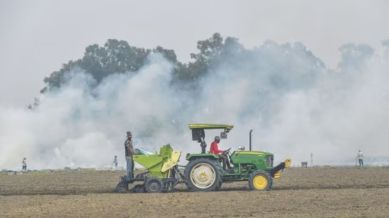Stay updated with the latest - Click here to follow us on Instagram
The economics of balers — big-bucks machines that run for hardly 40 days
Punjab today has 2,000-odd balers and rakes that collect the leftover straw from paddy harvested using combines.

Imagine investing Rs 18 lakh in a machine that runs for barely 40 days of the year. That’s what Punjab’s baler operators – who cut the standing paddy stubble from farmers’ fields and supply it as compacted blocks to user industries – are now doing and also making some money from that investment.
Mandeep Singh, a farmer himself from Kangna village of Jalandhar district’s Nakodar tehsil, has bought a ‘Shaktiman’ square baler, rake and paddy straw cutter – all tractor-powered machines – at a total cost of Rs 18 lakh.
monthly limit of free stories.
with an Express account.
The cutter chops the standing stubble from the roots. This harvested straw, after being allowed to dry for two days, is then collected and laid in straight rows by the rake. The baler compresses the straw into square bundles and also binds them by a polypropylene twine. It is these easily-transportable compact straw bales, weighing 25-30 kg each, that Singh supplies to a biomass-based power plant at Bir Pind village in Nakodar.
The Rs 18 lakh investment – it would be higher for brands such as New Holland and Massey Fergusson – isn’t much of an issue, given that there is a 50 per cent government subsidy given on crop residue management machinery. The problem is with the number of days the machine can operate on the ground.
Paddy harvesting in Punjab starts from end-September and extends up to mid-November. Singh says that his balers – he has three of them – can run for about 40 days and cover 15-20 acres daily. Taking an average of 17 acres over 40 days and stubble yield of 25 quintals per acre, he can deliver roughly 17,000 quintals of baled paddy straw to the 10-megawatt biomass-based power plant of Green Planet Energy Pvt Ltd, which pays him a price of Rs 150 per quintal. That translates into gross revenue of Rs 25.50 lakh from each baler.
As for costs, a 55-horsepower tractor-mounted baler covers an acre in half an hour and consumes 4 litres of diesel. The straw cutter and rake similarly burn 3.5-4 litres and 2 litres over 35-40 minutes and 20 minutes respectively. At Rs 88.3 per litre, the cost of fuel alone comes close to Rs 900 per acre or Rs 6.1 lakh over 680 acres.
The next major cost head is labour and trolley hiring charges. Singh engages 5 people: one driver each for the baler, rake and straw cutter, plus one helper each for the first two. At Rs 500/worker/day, the total labour cost over 40 days would be Rs 1 lakh. The baled straws are transported by two tractor trolleys, each carrying 80-100 quintals. These, along with the workers to load the bales from the fields and unload at the power plant, are hired at the rate of Rs 70/quintal. So, for 17,000 quintal of straw, that would be Rs 11.9 lakh.
The polypropylene twines cost Rs 16 for every quintal of straw or Rs 2.7 lakh for 17,000 quintals. Maintenance and repair of the baler, rake, cutter and the tractors would add another Rs 1-1.5 lakh. In all, Singh’s costs work out to some Rs 23 lakh, as against revenues of Rs 25.5 lakh. “I do charge farmers Rs 1,000 per acre for cutting and lifting the baled straw from their fields. But not everyone is willing to pay me that amount,” says Singh.
Punjab today has 2,000-odd balers and rakes that collect the leftover straw from paddy harvested using combines. These machine operators ensure that the stubble, instead of being set on fire, is lifted and delivered as compacted bales – whether to biomass-based power, compressed biogas and ethanol plants or paper mills and brick kilns. In short, they help convert fire/waste into energy/wealth.
But given the short time window during which these machines operate – covering 500-700 acres over 35-40 days – they defy ordinary return-on-investment calculations.